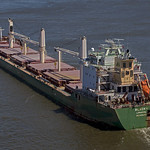What are the different types of vessels?
- copemer
- Jan 11, 2021
- 3 min read
Updated: Jan 13, 2021
Today I will talk about the different types of vessels we supply, and some factors to consider when we supply.
Bulk Carrier
Bulk carriers can carry large quantities of dry goods - for example, grains, coal, wood chip, hay, and ore. The modern ships have separate compartments to carry different types of commodities.
This type of ship can carry seasonal produce (grain harvest, rice harvest) so how the ships are used can change frequently. Bunkering can be tricky, often it is necessary to anticipate last minute changes and wait for availability of services and trades. This can cause changes to the port of loading or discharging. It is better to secure the product on a spot basis (where services/trades are effective immediately for the spot price quoted). This is because contracts often require a minimum quantity lift, and if the quantity cannot be lifted, a penalty will be charged.
Container ships
Container ships are like bus services in that they have a pre-arranged port rotation which the vessel will rotate on schedule.
It is easy to take a contract for bunkering, knowing in advance which port of rotation offers the lower prices. Normally a big container hub port (such as Singapore, Hong Kong or Rotterdam) offers lower bunker prices, and having a contract in place prioritises the vessel for bunkers and avoids any potential fuel shortages. It's important to note a possible risk for container ships with contracts, as there could be a possibility that the vessel will omit a port in case of severe delays. However the hub ports are very rarely omitted.
Cruise ships are similar to container ships, in that they operate on a port rotation basis.

The only difference between the container ships are the products that are bunkered. Because container ships sail in the open water, they take VSLFO (very low sulfur fuel oil) which is 0.5% max sulfur. On the other hand, a cruise ship is obliged to burn LSMGO (Low Sulfur Marine Gas Oil) which contains less that 0.1% sulfur, because they sail from port to port frequently, often for a half-day or a daily voyage.
The lower sulfur content is, as the name suggests, a more refined fuel, and hence more expensive.
Tankers

When we think of tankers, we often think of oil tankers. However there are other types of tankers, such as chemical tankers or LNG (liquified natural gas) tankers.
A chemical tanker is a type of tanker ship designed to transport chemicals in bulk. These ships are constructed or adapted for carrying in bulk any liquid product, which are often very dangerous and inflammable. Bunkering operations for tankers are usually performed outside normal operational hours, to minimise risk to a busy port. Sometimes the berth won't allow bunkers at all for these types of ships.
Offshore service vessels

There are many different types of offshore service vessels. The picture shows tag boats, which help big ships to manoeuvre in and out of the port.
Service vessels often help port services to transport certain services to specific and often near-port destinations, for example, to shuttle food and personal services to an oil rig. They can also assist off-shore projects by carrying materials to offshore wind farm constructions. The main issue to consider when bunkering these vessels is related to tax. Bunkering will be subject to duty tax and/or VAT, both of which are applicable depending on the port and activity that is performed by the service vessel.
Hopefully this blog has met its aims to provide you with a brief yet informed summary of the differences between vessels, and share expertise on some of the key factors to be aware of when bunkering and moving around ports. As always, if you have any queries about the information contained within this blog or if you would like more information – please contact copemer@copemer.com








Comments